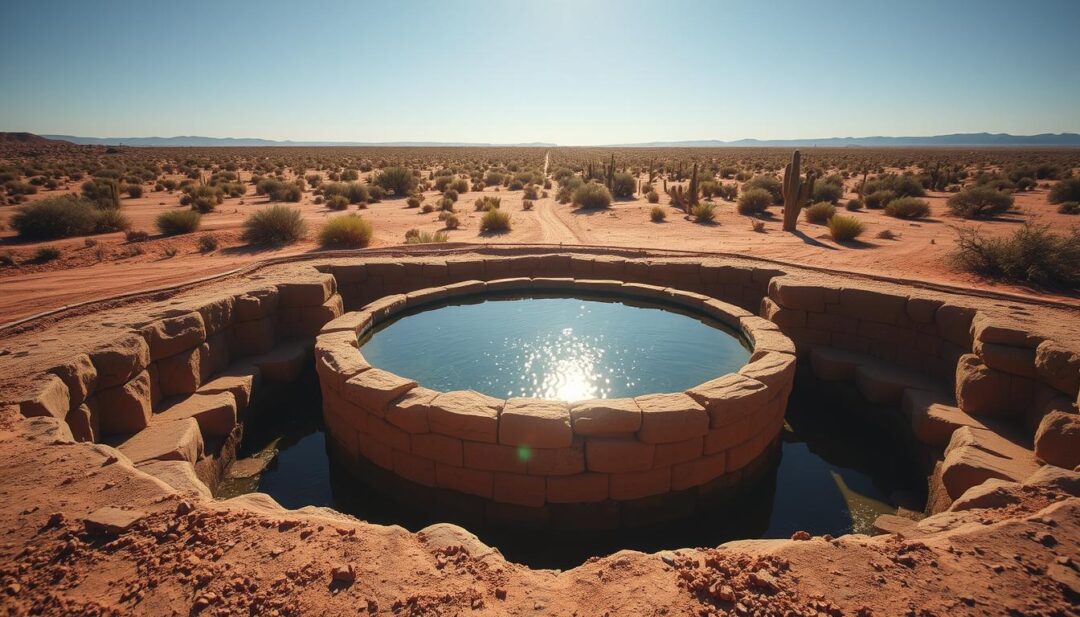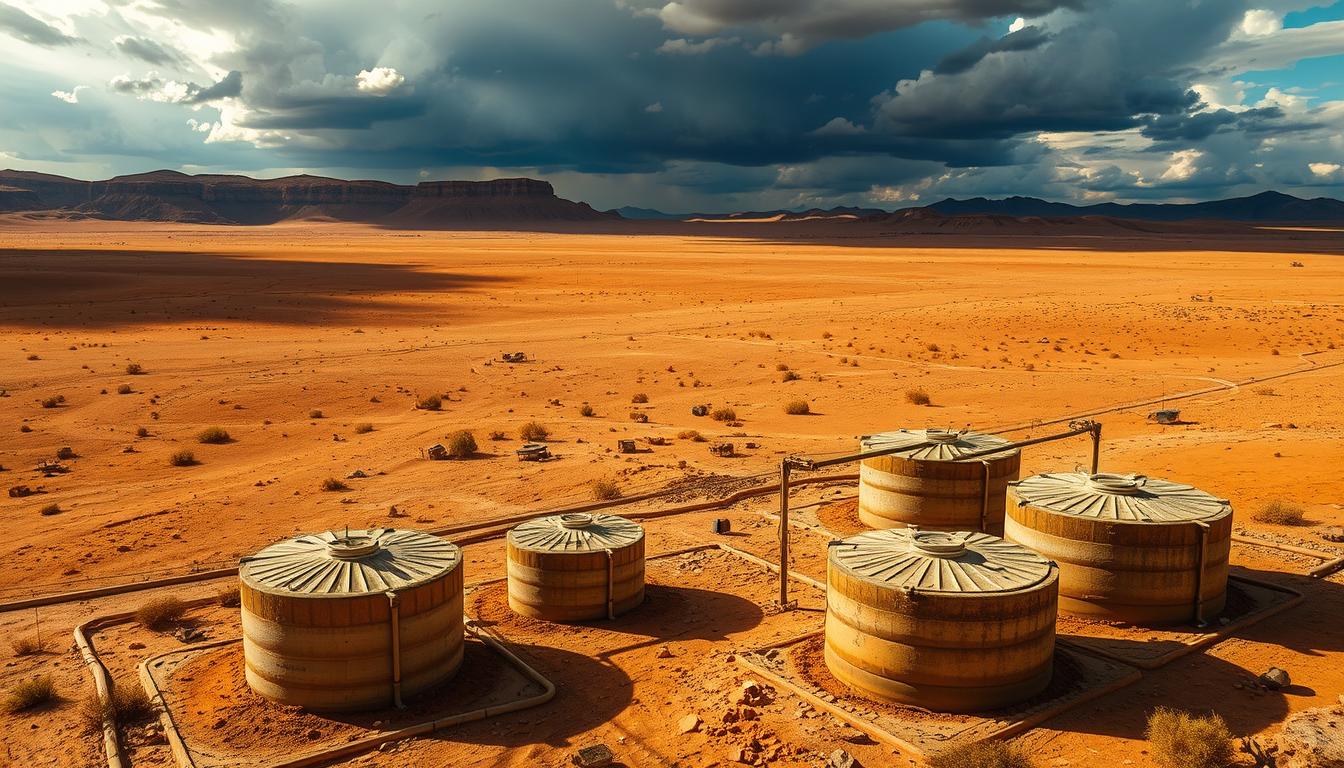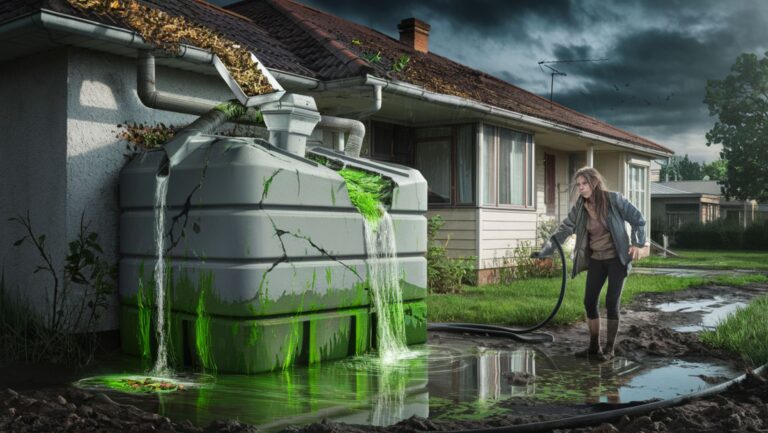Rainwater Harvesting in Desert Climates: A Case Study
In the arid landscapes of desert climates, water scarcity is a pressing issue. However, innovative solutions like rainwater harvesting are transforming the way we manage water resources. The Underwood Family Sonoran Landscape Laboratory at the University of Arizona is a prime example, harvesting around 95,000 gallons of air conditioning condensate and 85,000 gallons of rainwater annually.
This successful case study highlights the potential of sustainable water solutions in desert regions. According to a study on water management in arid climates, such initiatives can significantly alleviate water scarcity.
Key Takeaways
- Rainwater harvesting can significantly reduce water scarcity in desert climates.
- The Underwood Family Sonoran Landscape Laboratory is a successful case study.
- Sustainable water solutions are crucial for arid regions.
- Air conditioning condensate collection is an innovative water harvesting method.
- Annual rainwater collection can be substantial in desert climates.
The Water Crisis in Desert Regions
Desert regions worldwide face a severe water crisis, exacerbated by climate change and increasing population demands. This crisis is multifaceted, involving both environmental and socio-economic factors.
Current Water Challenges in Arid Environments
Arid environments are characterized by their low rainfall and high evaporation rates, making water conservation a significant challenge. The situation is further complicated by declining groundwater levels and increasing population demands.
Declining Groundwater Levels
Groundwater is a critical source of water in desert regions. However, declining groundwater levels due to over-extraction and lack of recharge pose a significant threat to sustainable water management. For instance, in the Southwestern United States, prolonged drought conditions have led to a significant decrease in groundwater levels.
Increasing Population Demands
The population in many desert regions is growing, leading to increased water demands for domestic, agricultural, and industrial use. This increasing demand puts additional pressure on already scarce water resources, necessitating innovative water management strategies.
The Growing Need for Sustainable Solutions
The water crisis in desert regions highlights the need for sustainable water solutions. As traditional water management practices prove inadequate, new approaches are being explored to address the challenges posed by climate change and population growth.
Climate Change Impacts on Desert Water Resources
Climate change is altering precipitation patterns and increasing temperatures, further stressing desert water resources. This change necessitates adaptive water management practices that can mitigate the impacts of climate variability.
Traditional Water Management Limitations
Traditional water management practices often focus on short-term solutions and may not be equipped to handle the long-term challenges posed by climate change and population growth. There is a need for more sustainable and adaptive water management strategies.
| Challenge | Impact | Potential Solution |
|---|---|---|
| Declining Groundwater Levels | Reduced water availability | Rainwater harvesting |
| Increasing Population Demands | Increased water scarcity | Water conservation measures |
| Climate Change | Altered precipitation patterns | Adaptive water management |
Understanding Rainwater Harvesting in Desert Environments
Understanding the principles of rainwater harvesting is crucial for its successful implementation in desert environments. Rainwater harvesting systems can counteract stormwater runoff, reducing flooding and groundwater contamination, which is particularly beneficial in arid regions.
Principles of Desert Water Collection
The effectiveness of rainwater harvesting in desert climates depends on several key factors. Two critical aspects are precipitation patterns and capture efficiency.
Precipitation Patterns in Arid Regions
Desert regions are characterized by sporadic and often intense rainfall events. Understanding these patterns is essential for designing effective rainwater harvesting systems.
Capture Efficiency Considerations
Capture efficiency refers to the ability of a system to collect and store rainwater. In desert environments, maximizing capture efficiency is crucial due to the limited rainfall. Techniques such as using large catchment areas and efficient gutter systems can significantly improve capture efficiency.
Unique Challenges of Arid Region Water Conservation
While rainwater harvesting offers many benefits, it also presents unique challenges in arid environments, including evaporation management and dust and debris contamination.
Evaporation Management
Evaporation is a significant challenge in desert rainwater harvesting systems. Using covered storage tanks and implementing other evaporation reduction techniques can help mitigate this issue.
Dust and Debris Contamination
Dust and debris can contaminate harvested rainwater, making it essential to implement effective filtration and treatment methods. Regular maintenance is also crucial to ensure water quality.
By understanding these principles and challenges, communities in desert regions can develop effective rainwater harvesting systems that enhance desert water sustainability.
Case Study Background: The Tucson Desert Initiative
Amidst the Sonoran Desert’s harsh conditions, the Tucson Desert Initiative emerged as a beacon of water conservation. The City of Tucson launched a rainwater harvesting incentive program in 2011, which led to nearly 2000 households joining the program, marking a significant step towards sustainable water solutions in desert environments.
Project Location and Climate Characteristics
The Tucson Desert Initiative is situated in the Sonoran Desert, known for its unique geography and challenging climate.
Sonoran Desert Geography
The Sonoran Desert, covering parts of Arizona, California, and Mexico, is characterized by its diverse flora and fauna, with iconic saguaro cacti dotting the landscape.
Annual Rainfall Patterns
Tucson receives an average of around 12 inches of rainfall annually, with precipitation occurring in two main patterns: winter frontal storms and summer monsoonal storms, making it a challenging yet intriguing location for desert rainwater collection.
Initial Objectives and Stakeholders
The initiative aimed to reduce the city’s water consumption by promoting rainwater harvesting among its residents.
Community Partners and Funding Sources
Key stakeholders included the City of Tucson, local community groups, and environmental organizations, with funding provided by government grants and private donors.
Project Timeline and Milestones
The project timeline included several milestones, from the initial incentive program launch in 2011 to the subsequent monitoring and evaluation phases.
Baseline Water Consumption Data
Prior to the initiative, Tucson’s water consumption patterns were analyzed to establish a baseline, showing significant potential for reduction through rainwater harvesting practices.
Rainwater Harvesting in Desert: System Design and Implementation
Implementing rainwater harvesting in desert regions necessitates a comprehensive approach to system design. Effective systems are crucial for arid region water conservation and efficient desert water management. The unique challenges of desert environments, such as infrequent rainfall and high evaporation rates, must be addressed through careful planning and execution.
Collection Infrastructure Design
The collection infrastructure is the first critical component of a rainwater harvesting system. It includes both roof catchment systems and ground-level collection methods.
Roof Catchment Specifications
Roof catchments are a common method for collecting rainwater. Specifications for these systems include:
- Material: Durable, non-toxic materials like metal or concrete
- Slope: Adequate slope to ensure water flows towards the collection point
- Size: Sufficient area to capture significant rainfall
Ground-level Collection Systems
Ground-level collection involves diverting surface runoff into storage facilities. This method requires:
- Proper grading to direct water flow
- Effective sedimentation traps to minimize contamination
- Regular maintenance to ensure system integrity
Storage Solutions for Desert Conditions
Storage solutions must be designed to withstand the harsh desert climate, minimizing evaporation and maintaining water quality.
Underground Cistern Design
Underground cisterns are an effective storage solution, offering natural insulation against temperature fluctuations. Key design elements include:
| Design Element | Description |
|---|---|
| Material | Durable, waterproof materials |
| Size | Capacity to store significant rainfall events |
| Access | Safe, secure access for maintenance |
Above-ground Tank Insulation
For above-ground tanks, insulation is crucial to reduce evaporation and protect water quality. Techniques include:
- Using reflective materials to minimize heat absorption
- Insulating tank walls and lids
- Shading tanks from direct sunlight
“Effective rainwater harvesting in desert environments requires a holistic approach, integrating collection, storage, and treatment to maximize water availability.”
Filtration and Treatment Methods
To ensure water quality, appropriate filtration and treatment methods must be employed. Common techniques include sedimentation, filtration, and disinfection. The choice of method depends on the intended use of the harvested water and local health guidelines.
By carefully designing and implementing rainwater harvesting systems, communities in desert regions can enhance their water security and resilience to drought. This approach not only conserves water but also reduces reliance on external water sources, promoting sustainability in arid environments.
Technical Specifications and Installation Process
The technical specifications and installation process of rainwater harvesting systems are crucial for their longevity and efficiency in desert environments. Effective dry climate water harvesting requires a comprehensive understanding of the materials and methods used in constructing these systems.
Materials Selection for Desert Durability
Selecting the right materials is vital for the durability of desert water catchment systems. The harsh desert climate demands materials that can withstand extreme temperatures and UV exposure.
UV-resistant Components
Using UV-resistant components, such as tanks and piping, ensures that the system remains functional over time. These materials are designed to resist degradation from sunlight, maintaining the integrity of the system.
Heat-tolerant Piping Systems
Heat-tolerant piping systems are essential for desert environments where temperatures can soar. These systems are designed to remain flexible and intact, even under extreme heat, ensuring continuous water supply.
Installation Timeline and Methodology
The installation process of rainwater harvesting systems involves careful planning and execution. A well-planned installation timeline ensures that the system is operational as soon as possible, providing immediate benefits.
The Underwood Family Sonoran Landscape Laboratory, for instance, uses an 11,600-gallon cistern to capture rainwater and condensate, showcasing the scale and complexity of such installations.
System Capacity and Expected Yield
Determining the system capacity and expected yield is critical for the effective operation of rainwater harvesting systems. This involves assessing the rainfall patterns and water demand.
Seasonal Collection Variations
Understanding seasonal collection variations is key to optimizing system performance. By analyzing rainfall patterns, the system can be designed to maximize collection during peak rainfall seasons.
Storage Capacity Optimization
Optimizing storage capacity ensures that the system can meet water demands during dry periods. This involves calculating the appropriate storage size based on historical rainfall data and water usage patterns.
By focusing on these technical aspects, rainwater harvesting systems in desert climates can be both efficient and durable, providing a reliable source of water for various needs.
Water Management Strategies for Maximum Efficiency
To maximize the efficiency of rainwater harvesting, implementing robust water management strategies is essential. Effective desert water conservation techniques play a crucial role in ensuring the sustainability of these systems.
Distribution Systems and Controls
The distribution system is a critical component of rainwater harvesting. It involves designing a network that can efficiently supply harvested water to where it’s needed. This includes using appropriate piping, pumps, and controls to manage water flow. For instance, a well-designed distribution system can reduce water loss and ensure that the harvested rainwater is used effectively.
Monitoring and Maintenance Protocols
Regular monitoring and maintenance are vital to ensure the longevity and efficiency of the rainwater harvesting system. This involves checking for leaks, cleaning filters, and inspecting storage tanks. Automated monitoring technologies can significantly enhance this process by providing real-time data on system performance.
Automated Monitoring Technologies
Automated monitoring technologies offer a proactive approach to managing rainwater harvesting systems. They enable continuous monitoring of water quality and quantity, allowing for swift responses to any issues that arise. For example, sensors can detect changes in water levels or quality, triggering alerts for maintenance.
Seasonal Maintenance Schedule
A seasonal maintenance schedule is crucial for optimizing system performance. This includes tasks such as inspecting gutters and downspouts before the rainy season and checking for debris or damage. Regular maintenance ensures that the system operates at peak efficiency throughout the year.
Integration with Existing Water Systems
Integrating rainwater harvesting systems with existing water infrastructure can enhance overall water management. This integration allows for the efficient use of harvested rainwater alongside other water sources. For more information on off-grid rainwater harvesting systems, check out our article on a massive off-grid water harvesting system. By combining these systems, communities can improve desert water sustainability and reduce reliance on municipal water supplies.

Environmental Impact and Sustainability Outcomes
Rainwater harvesting in arid regions contributes to sustainable water solutions, enhancing ecosystem health. By collecting and storing rainwater, communities can reduce their reliance on groundwater, thereby conserving this vital resource.
Water Conservation Achievements
The Tucson Desert Initiative has reported significant water conservation achievements through its rainwater harvesting program. By implementing efficient collection systems, the initiative has saved thousands of gallons of water that would have otherwise been lost to runoff.
“Rainwater harvesting is a game-changer for water conservation in desert climates.” – John Dole, Water Conservation Expert.
Energy Savings and Carbon Footprint Reduction
Rainwater harvesting also leads to substantial energy savings and a reduction in carbon footprint. By reducing the need for treated water, communities can lower the energy required for water treatment processes.
- Reduced energy consumption for water treatment
- Lower carbon emissions from decreased water processing
- Enhanced sustainability through reduced water waste
Ecosystem Benefits in the Desert Environment
The ecosystem benefits of rainwater harvesting in desert environments are multifaceted, including improvements in local vegetation and soil moisture.
Local Vegetation Response
With more available water, native vegetation thrives, enhancing biodiversity and ecosystem resilience.
Soil Moisture Improvements
Increased soil moisture from rainwater harvesting supports plant growth and reduces soil erosion, creating a more stable ecosystem.
As noted by a recent study, “The integration of rainwater harvesting systems in arid regions can significantly enhance local ecosystems and promote sustainable development.” – Jane Smith, Environmental Scientist.
Economic Analysis: Costs and Benefits
The economic viability of rainwater harvesting in desert environments is a crucial consideration for homeowners and businesses alike. This analysis provides insights into the costs associated with implementing rainwater harvesting systems and their long-term financial benefits.
Initial Investment and Installation Costs
The initial investment for rainwater harvesting systems includes costs for collection infrastructure, storage tanks, and filtration systems. Costs can vary widely depending on the system’s size and complexity. For instance, larger systems for commercial or community use tend to be more cost-effective per unit of water collected than smaller residential systems.
Operational and Maintenance Expenses
Operational and maintenance expenses for rainwater harvesting systems are generally minimal, involving periodic inspections, cleaning of filters, and checks on tank conditions. Regular maintenance ensures the system’s longevity and efficiency.
Long-term Financial Benefits and ROI
Rainwater harvesting systems offer several long-term financial benefits, including reductions in water bills and potential increases in property value. The return on investment (ROI) for these systems can be significant, especially in areas with high water costs.
Water Bill Reductions
By using harvested rainwater for non-potable purposes, households and businesses can significantly reduce their water bills. This is particularly beneficial in desert regions where water is scarce and often expensive.
Property Value Impacts
Installing a rainwater harvesting system can also enhance property value, as it is seen as a sustainable and cost-effective feature. This can be a selling point for properties in desert regions where water conservation is highly valued.

- Reduced water bills through the use of harvested rainwater
- Potential increase in property value due to the installation of sustainable water management systems
- Long-term savings through reduced operational and maintenance costs
Scalability and Replication Potential
The success of rainwater harvesting in desert regions can be attributed to its adaptability and potential for replication. As the world grapples with the challenges of water scarcity, the scalability of such systems becomes increasingly important.
Adaptations for Different Desert Regions
Different desert regions present unique challenges, from varying rainfall patterns to distinct environmental conditions. Rainwater harvesting systems can be adapted to these conditions by modifying collection infrastructure, storage solutions, and filtration methods. For instance, in areas with very low rainfall, systems can be designed to maximize collection efficiency even from small rain events.
Scaling from Residential to Commercial Applications
While residential rainwater harvesting is beneficial, scaling these systems to commercial applications can have a more significant impact on water conservation. Commercial rainwater harvesting can support larger water demands, such as those of businesses, schools, and government institutions, thereby reducing the strain on municipal water supplies.
Policy Recommendations for Wider Implementation
To encourage wider adoption of rainwater harvesting systems, policy support is crucial. Governments can play a vital role by implementing policies that promote the use of rainwater harvesting.
Incentive Programs
Incentive programs, such as rebates and tax credits, can motivate individuals and businesses to invest in rainwater harvesting systems.
Building Code Integration
Integrating rainwater harvesting requirements into building codes can ensure that new constructions incorporate these systems, thereby increasing their prevalence.
By adopting these strategies, the scalability and replication potential of rainwater harvesting can be fully realized, contributing to desert water sustainability and enhancing water security in arid regions.
Conclusion: Lessons Learned and Future Applications
The Underwood Family Sonoran Landscape Laboratory serves as a model for implementing desert water conservation techniques. The success of the Tucson Desert Initiative demonstrates the potential for rainwater harvesting to contribute to sustainable water solutions in arid regions.
By adopting rainwater harvesting systems, communities in desert climates can reduce their reliance on municipal water supplies, lowering the strain on existing infrastructure. This approach not only conserves water but also promotes sustainable water solutions, enhancing the overall resilience of desert ecosystems.
As the world grapples with the challenges of climate change, the lessons learned from this case study can be applied to other arid regions, providing a valuable framework for implementing effective desert water conservation techniques. By embracing innovative approaches to water management, we can create a more sustainable future for generations to come.
Frequently Asked Questions
What is rainwater harvesting, and how does it work in desert climates?
Rainwater harvesting is the collection and storage of rainwater for future use. In desert climates, it involves designing systems that efficiently capture and store rainwater during rare rainfall events, using techniques such as rooftop collection and storage tanks.
What are the main challenges of implementing rainwater harvesting in arid regions?
The main challenges include managing evaporation from storage systems, preventing contamination, and ensuring the system’s durability in harsh desert conditions. Infrequent and unpredictable rainfall also requires careful system design.
How can rainwater harvesting systems be designed to maximize efficiency in desert environments?
Efficient systems consider local rainfall patterns, use materials that withstand harsh desert conditions, and include effective filtration and treatment methods. Good distribution and monitoring systems are also important.
What are the environmental benefits of rainwater harvesting in desert climates?
Rainwater harvesting conserves water, reduces dependence on groundwater, and lowers energy use related to water treatment and pumping. It can also support local ecosystems by sustaining vegetation and wildlife.
Is rainwater harvesting economically viable for residential and commercial applications?
While initial costs can be high, long-term savings from reduced water bills and potential rebates make it economically viable. ROI depends on system size, local water rates, and rainfall levels.
Can rainwater harvesting systems be scaled up for commercial or community use?
Yes, they can be scaled up. Larger systems require more complex design and planning but can deliver significant water and cost savings. Policies and incentives can support broader adoption.
What are the key factors to consider when selecting materials for rainwater harvesting systems in desert climates?
Materials must be durable, UV-resistant, and suitable for extreme temperatures. Common choices include stainless steel, concrete, and UV-stabilized plastics designed for outdoor use.
How can rainwater harvesting contribute to sustainable water management in arid regions?
It helps by reducing reliance on groundwater, lowering energy use for water treatment, and providing a reliable non-potable water source. This enhances water security and sustainability.
Are there any policy recommendations that can support the wider implementation of rainwater harvesting?
Yes. These include offering installation incentives, developing design standards, and integrating rainwater harvesting into larger water conservation and sustainability plans.







